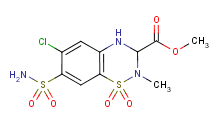-
Name
Carmetizide
- EINECS
- CAS No. 42583-55-1
- Density 1.618g/cm3
- Solubility
- Melting Point
- Formula C10H12 Cl N3 O6 S2
- Boiling Point 589.4°Cat760mmHg
- Molecular Weight 369.807
- Flash Point 310.3°C
- Transport Information
- Appearance
- Safety An experimental teratogen. When heated to decomposition it emits toxic fumes of Cl−, SOx, and NOx. See also ESTERS.
- Risk Codes
-
Molecular Structure
- Hazard Symbols
- Synonyms 2H-1,2,4-Benzothiadiazine-3-carboxylicacid, 6-chloro-3,4-dihydro-2-methyl-7-sulfamoyl-, methyl ester, 1,1-dioxide(7CI); Carmetizide; DU 5747
- PSA
- LogP
Carmetizide Chemical Properties
Molecule structure of Carmetizide (CAS NO.42583-55-1) :

IUPAC Name: methyl 6-chloro-2-methyl-1,1-dioxo-7-sulfamoyl-3,4-dihydrobenzo[e][1,2,4]thiadiazine-3-carboxylate
Molecular Weight: 369.80178 g/mol
Molecular Formula: C10H12ClN3O6S2
Density: 1.618 g/cm3
Boiling Point: 589.4 °C at 760 mmHg
Flash Point: 310.3 °C
Index of Refraction: 1.605
Molar Refractivity: 78.67 cm3
Molar Volume: 228.4 cm3
Polarizability: 31.18×10-24 cm3
Surface Tension: 59.7 dyne/cm
Enthalpy of Vaporization: 87.96 kJ/mol
Vapour Pressure: 7.19E-14 mmHg at 25 °C
XLogP3-AA: 0.1
H-Bond Donor: 2
H-Bond Acceptor: 9
Rotatable Bond Count: 3
Exact Mass: 368.985604
MonoIsotopic Mass: 368.985604
Topological Polar Surface Area: 136
Heavy Atom Count: 22
Complexity: 655
Canonical SMILES: CN1C(NC2=CC(=C(C=C2S1(=O)=O)S(=O)(=O)N)Cl)C(=O)OC
InChI: InChI=1S/C10H12ClN3O6S2/c1-14-9(10(15)20-2)13-6-3-5(11)7(21(12,16)17)4-8(6)22(14,18)19/h3-4,9,13H,1-2H3,(H2,12,16,17)
InChIKey: PFRBORHNFYMVOA-UHFFFAOYSA-N
Carmetizide Toxicity Data With Reference
| Organism | Test Type | Route | Reported Dose (Normalized Dose) | Effect | Source |
|---|---|---|---|---|---|
| mouse | LD | intraperitoneal | > 5gm/kg (5000mg/kg) | BEHAVIORAL: SOMNOLENCE (GENERAL DEPRESSED ACTIVITY) KIDNEY, URETER, AND BLADDER: URINE VOLUME INCREASED | Oyo Yakuri. Pharmacometrics. Vol. 7, Pg. 231, 1973. |
| mouse | LD | oral | > 10gm/kg (10000mg/kg) | KIDNEY, URETER, AND BLADDER: URINE VOLUME INCREASED | Oyo Yakuri. Pharmacometrics. Vol. 7, Pg. 231, 1973. |
| mouse | LD | subcutaneous | > 5gm/kg (5000mg/kg) | KIDNEY, URETER, AND BLADDER: URINE VOLUME INCREASED | Oyo Yakuri. Pharmacometrics. Vol. 7, Pg. 231, 1973. |
| rat | LD | intraperitoneal | > 5gm/kg (5000mg/kg) | BEHAVIORAL: SOMNOLENCE (GENERAL DEPRESSED ACTIVITY) KIDNEY, URETER, AND BLADDER: URINE VOLUME INCREASED | Oyo Yakuri. Pharmacometrics. Vol. 7, Pg. 231, 1973. |
| rat | LD | oral | > 10gm/kg (10000mg/kg) | KIDNEY, URETER, AND BLADDER: URINE VOLUME INCREASED | Oyo Yakuri. Pharmacometrics. Vol. 7, Pg. 231, 1973. |
| rat | LD | subcutaneous | > 5gm/kg (5000mg/kg) | KIDNEY, URETER, AND BLADDER: URINE VOLUME INCREASED | Oyo Yakuri. Pharmacometrics. Vol. 7, Pg. 231, 1973. |
Carmetizide Safety Profile
An experimental teratogen. When heated to decomposition it emits toxic fumes of Cl−, SOx, and NOx. See also ESTERS.
Carmetizide Specification
Carmetizide (CAS NO.42583-55-1) is also called 6-Chloro-3-carbomethoxy-3,4-dihydro-2-methyl-2H-1,2,4-benzothiadiazine-7-sulfonamide 1,1-dioxide ; BRN 0715143 ; Carbomethoxythiazide ; Carmetizida ; Carmetizida [INN-Spanish] ; Carmetizidum ; Carmetizidum [INN-Latin] ; DU 5747 ; DU-5747 ; 2H-1,2,4-Benzothiadiazine-3-carboxylic acid, 7-(aminosulfonyl)-6-chloro-3,4-dihydro-2-methyl-, methyl ester, 1,1-dioxide ; Methyl 6-chloro-3,4-dihydro-2-methyl-7-sulfamoyl-2H-1,2,4-benzothiadiazine-3-carboxylate 1,1-dioxide . Carmetizide (CAS NO.42583-55-1) is low toxic. It will produce toxic nitrogen oxides, sulfur oxides and chlorine fumes by heat. So the storage environment should be ventilate, low-temperature and dry.
About|Contact|Cas|Product Name|Molecular|Country|Encyclopedia
Message|New Cas|MSDS|Service|Advertisement|CAS DataBase|Article Data|Manufacturers | Chemical Catalog
©2008 LookChem.com,License: ICP
NO.:Zhejiang16009103
complaints:service@lookchem.com Desktop View